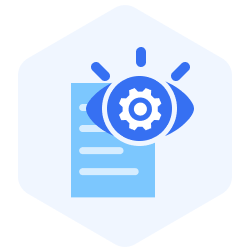Supervised Machine Learning: The Complete Guide

Supervised Machine Learning: The Complete Guide
Supervised machine learning uses labeled data to train models to make predictions. In this post you’ll learn what supervised learning is, the components, types of algorithms and use cases.
Summary
Supervised learning uses labeled data to train machine learning models for classification and regression to make predictions.
Components of supervised learning are input features which describe the data and output labels which are the desired outcomes for the model to learn.
Challenges in supervised learning like overfitting and underfitting requires careful data handling and validation techniques to ensure models generalize well to new data.
What is Supervised Machine Learning
 An infographic showcasing various applications of supervised learning
An infographic showcasing various applications of supervised learning
Supervised learning is the foundation of supervised machine learning, it uses labeled data to train models. It works by feeding the machine a set of input data along with the corresponding output data and the model learns and predicts outcomes. This is like teaching a student a set of questions and their answers so they understand the concepts of unsupervised machine learning.
Supervised machine learning is effective for various tasks especially classification and regression. Classification tasks involve categorizing data into pre-defined classes, like spam detection in emails and regression tasks predict continuous outcomes, like house prices.
The manual effort involved in labeling data ensures the models learn from accurate input-output relationships, making supervised learning a powerful tool in the machine learning arsenal.
Supervised Machine Learning
At the core of supervised machine learning are labeled datasets which are input features paired with output labels. These datasets are carefully crafted to train algorithms to classify data and make predictions. The training process involves gathering representative labeled training data along with their corresponding outputs to give the model something to look for and relate to.
Input features are the attributes or characteristics of the input and output data that are needed to make predictions. For example in a house price prediction model features might be the square footage, number of bedrooms and location.
Output labels are the desired outcomes that the model is trying to predict, for example the actual price of the house. A key part of this process is how to represent these input features effectively for the learning function.
Types of Supervised Machine Learning Algorithms
Supervised learning includes many algorithms, each for solving specific types of problems, including supervised vs unsupervised learning. Generally these algorithms are classified into classification and regression algorithms. Classification algorithms are used to assign input data into pre-defined categories, regression algorithms are used to predict continuous outcomes.
Let’s dive deeper into these categories to understand their methods and applications.
Classification Algorithms
Classification algorithms are the heart of supervised machine learning, used to find patterns and assign input data into specific categories. Logistic regression is a popular algorithm for binary classification, for example, to detect spam emails. Logistic regression predicts if an email is spam by looking at features like presence of certain keywords.
Support Vector Machines (SVM) takes a different approach by creating an optimal hyperplane that separates the classes of data. This makes SVM good for tasks that require clear distinction between categories, like classifying images of handwritten digits.
On the other hand, neural networks including Convolutional Neural Networks (CNNs) are more complex. They mimic human brain connectivity through multiple layers of mathematical transformations, making them good for image classification tasks like detecting tumors in medical imaging.
The K-Nearest Neighbors (KNN) algorithm predicts the class of a given sample based on the majority class among its k closest neighbors. This simplicity makes KNN good for applications like facial recognition software, which identifies individuals by comparing new images to a database of labeled images.
Each of these algorithms has unique strengths, making them suitable for different classification tasks.
Regression Algorithms
Regression algorithms are used to predict continuous outcomes by finding relationships between variables. Linear regression is a basic one in this category to predict values on a continuous scale. For example, a simple linear regression can predict house prices based on size and location. This is finding a linear relationship between input variables and the target output.
Decision Trees is another regression tool, uses a tree like structure of if-else statements to predict outcomes. Each branch is a decision rule and each leaf node is an outcome. This is intuitive and easy to visualize, useful for tasks like predicting patient outcomes based on medical history.
Both linear regression and decision trees are part of supervised machine learning, to predict continuous values. They are used in many domains, finance to healthcare.
Training Process in Supervised Machine Learning
The training process in supervised machine learning involves several critical steps to ensure that models can accurately predict outcomes. It begins with data preprocessing, followed by model training, and ends with model evaluation. Each phase is important in transforming raw data into a reliable machine learning model capable of making precise predictions.
Data Preprocessing
Data preprocessing is the first step in the training process where the training set is the labeled data points along with correct outputs. This step ensures the input data is clean and ready for training which often includes handling missing values and scaling features. Feature scaling is very important as it normalizes the range of independent variables so that no single feature dominates the learning.
The preprocessing step also involves exploratory data analysis to understand the data patterns and relationships. This step helps in identifying any anomalies or outliers that might skew the training. By doing data preprocessing we lay the foundation for the next steps in the model training.
Model Training
In the model training phase, the algorithms process the labeled data to find the patterns that map inputs to outputs. This involves parameter tuning which is very important to increase the predictive accuracy of the trained model. Decision Trees can be used for both classification and regression tasks by modeling the decisions through a tree like structure and help the model to learn from the data.
The training process also involves iterative adjustments to minimize the errors and improve the performance. Continuous refinement helps to find the balance between fitting the training data well and generalizing to new unseen data.
Model Evaluation
Model evaluation is the last step where we evaluate the trained model using various performance metrics. Metrics like accuracy and precision are used to see how the model performs on test data. This step ensures the model can generalize to new data and give reliable predictions in real world applications.
Cross validation techniques are used to further validate the model’s performance. Splitting the training data into subsets for testing helps in understanding the model’s capability to handle new data and avoid overfitting.
Applications of Supervised Learning
 An infographic showcasing various applications of supervised learning
An infographic showcasing various applications of supervised learning
Supervised learning has a broad spectrum of applications across various industries. From agriculture, where it assesses crop health, to self-driving cars identifying road signs, its impact is far-reaching.
Let’s explore some specific applications to understand its practical significance.
Image Classification
In image classification, supervised learning algorithms are trained on labeled images to accurately identify objects within them. This process involves feeding the model thousands of labeled images, enabling it to learn and categorize new images accurately. For instance, in medical imaging, Convolutional Neural Networks (CNNs) are used to detect tumors, significantly improving diagnostic accuracy.
Supervised machine learning in image classification extends to various fields, including security, where it helps in facial recognition systems. These systems enhance security and streamline processes in airports, offices, and other high-security areas by identifying and categorizing images.
Spam Detection
Spam detection is a classic application of supervised learning and natural language processing, where models are trained using labeled datasets of spam and legitimate emails. By analyzing features such as sender information, email content, and subject lines, these models can classify incoming emails as spam or non-spam with high accuracy.
This application not only improves email filtering but also enhances user experience by reducing the clutter in inboxes. The continuous learning from labeled data ensures that spam detection systems stay updated with new spam tactics, maintaining their effectiveness over time.
Medical Diagnosis
In healthcare, supervised machine learning plays a role in diagnosing diseases through predictive analytics. By analyzing medical images and patient data, models can predict the likelihood of conditions such as cancer and cardiovascular diseases with remarkable accuracy. Convolutional Neural Networks (CNNs) and logistic regression are commonly used for these tasks, leveraging vast datasets of medical images and patient records.
The integration of supervised machine learning techniques into healthcare has significantly improved patient outcomes, enabling faster and more reliable diagnoses. This advancement not only enhances the accuracy of medical diagnoses but also speeds up the decision-making process, leading to better patient care.
Challenges in Supervised Machine Learning
 A conceptual illustration of the challenges faced in supervised learning
A conceptual illustration of the challenges faced in supervised learning
Despite its numerous advantages, supervised learning faces several challenges. Overfitting occurs when a model learns the training data too well, capturing noise instead of genuine patterns. This is especially problematic with complex models having many parameters, as they can too closely mirror the training data. To mitigate this, using a larger and more diverse labeled dataset is essential.
On the other hand, underfitting happens when a model is too simplistic to grasp the underlying data patterns, resulting in poor performance on both training and new data. Cross-validation techniques help in ensuring that the model generalizes well to unseen data, thus balancing the risks of overfitting and underfitting.
Additionally, the accuracy of supervised learning models can be compromised by human errors in labeling training data.
Semi-Supervised Learning: A Hybrid Approach
 A visual representation of semi-supervised learning as a hybrid approach
A visual representation of semi-supervised learning as a hybrid approach
Semi-supervised learning combines the best of both supervised and unsupervised learning by utilizing both labeled and unlabeled data. Initially, an algorithm is trained on a small labeled dataset, then this model is used to predict labels on a larger unlabeled dataset. These predicted labels are added to the labeled dataset, and the process is repeated to improve the model’s accuracy iteratively.
This hybrid approach is particularly useful in situations where labeled data is scarce but unlabeled data is abundant. Semi-supervised learning significantly enhances model performance by utilizing vast amounts of unlabeled data, reducing the manual effort required for data labeling.
Tools and Frameworks for Supervised Learning
 An illustration of popular tools and frameworks used in supervised learning
An illustration of popular tools and frameworks used in supervised learning
A variety of tools and frameworks are available to facilitate supervised learning. Scikit-learn, a Python library, is known for its simplicity and efficiency in data analysis, making it a favorite among data scientists. TensorFlow, developed by Google, is an open-source platform renowned for its deep learning capabilities, ideal for building and deploying complex models.
PyTorch, one of the newer frameworks has gained in popularity recently and offers GPU acceleration and is favored for its flexibility and dynamic computation graphs, making it particularly suitable for research-oriented projects. These tools and frameworks are indispensable in the realm of supervised learning, streamlining the process of building, training, and deploying machine learning models.
Summary
Supervised learning is the backbone of machine learning, for precise predictions and data classification. From understanding the basics to exploring algorithms and real world applications this guide has covered everything you need to master supervised learning. Overcoming overfitting and using hybrid approaches like semi-supervised learning makes it even more powerful.
The journey through supervised learning shows its impact across industries from healthcare to cybersecurity. As you go deeper into this, the knowledge and insights here will empower you to unlock the full power of supervised learning and achieve amazing results in your projects.
Frequently Asked Questions
What is supervised learning, and how does it differ from unsupervised learning?
This type of learning is defined by using labeled training data to make accurate predictions, while unsupervised learning is about finding patterns without labeled data. This difference shows the different approach each method takes in model training.
What are the main types of supervised learning algorithms?
The main types are classification algorithms which assign input data to pre-defined categories and regression algorithms which forecast continuous values. Knowing these is important to choose the right approach for your data analysis.
How does data preprocessing affect the training process in supervised learning?
Data preprocessing affects the training in supervised learning by ensuring the input data is accurate and well structured so the model can learn. Handling missing values and scaling features can improve model performance and give more accurate predictions.
What are some common challenges in supervised learning?
Overfitting and underfitting are the common challenges in supervised learning; overfitting is when a model is too specialized to the training data and underfitting is when a model is too simple. Cross validation can solve these issues.
Which tools and frameworks are popular for implementing supervised learning models?
Scikit-learn, TensorFlow, PyTorch are the popular tools and libraries to use for supervised learning, each has its own advantages like simplicity, deep learning capabilities and flexibility. Choose the one that suits your project and expertise.
- Summary
- What is Supervised Machine Learning
- Supervised Machine Learning
- Types of Supervised Machine Learning Algorithms
- Training Process in Supervised Machine Learning
- Applications of Supervised Learning
- Challenges in Supervised Machine Learning
- Semi-Supervised Learning: A Hybrid Approach
- Tools and Frameworks for Supervised Learning
- Summary
- Frequently Asked Questions
Content
Start Free, Scale Easily
Try the fully-managed vector database built for your GenAI applications.
Try Zilliz Cloud for Free